'My Uncle Was Shot in the Massacre'
An excerpt from my new book, companion to the PBS film.
Here’s a rather startling piece that may interest you.
As I noted last week, my new film Memorial Day Massacre: Workers Die, Film Buried, premiered on PBS stations earlier this month but is now streaming online and via PBS apps for free everywhere. Please go watch, it’s only 26 minutes, and narrated by Josh Charles, produced by Lyn Goldfarb, and then share with others and let me know in Comments what you think. I’ve also written a companion book, the first oral history, with everyone from wounded activists to Studs Terkel, Gore Vidal, and Howard Zinn. Background and early praise from notables here.
When I first grew interested in this subject last autumn, after completing two other films in the previous two years, the first major piece I read was an article in an academic journal by Carol Quirke, a professor at the State University of New York at Old Westbury. In it she provided background (new for me) on the 1937 tragedy in Chicago when police shot (mainly in the back) and killed ten striking steel workers and supporters. She also explored, rather brilliantly, the suppression of the only footage by Paramount News and analyzed key moments in it. I saw that she had also written a book, Eyes on Labor, and I ordered and read the lengthy chapter in it that covered much of the same ground.
This inspired me to rush ahead and obtain the once-hidden footage and try to make the film. So I wrote her and asked if she would like to be chief adviser. She agreed, and only then did I learn this shocking fact: She had grown up only about a mile from the Massacre site—and one of her uncles had been shot that day in the leg! When I put together the companion book, I asked her to write the forward (mainly on her family connection) and afterword (on the footage).
So below find an excerpt from that forward. Below that our usual political cartoons. Enjoy, then please spread the word about the film/book, and subscribe to this newsletter if you have not—it is also free!
A Family Wound
by Carol Quirke
You might think that, having been raised a mile from where 10 workers were killed and 30 more were shot by police while picketing a steel plant, I would have heard of such a tragedy. More confounding, my great-uncle, Eddie Marasovic, was wounded by a police bullet in that violent affair that would become known as a massacre. Yet I knew nothing of it.
It happened in May, 1937, before I was born, on the prairie outside the Republic Steel plant on Chicago’s East Side. This spit of land, along Lake Michigan’s southern tip, linked the steel plants of southern Chicago to a long string of industry that reached through Indiana, giving rise to what labor economists called the largest steel producing region in the world.
Why did I only learn about the killing of workers from a poster of the massacre that I found in a bookstore, in a city located two states away, nearly half a century after the event transpired?
The Memorial Day Massacre, as many refer to it, was largely repressed by many in the community where it occurred. In the late 1990s when I began researching it, scholars had also neglected the tragedy for decades. Greg Mitchell’s new PBS film and book, Memorial Day Massacre: Workers Die, Film Buried, explore how vital evidence — a Paramount newsreel — helped union leaders and civil libertarians turn the tide against the extreme pro-police news coverage in the immediate aftermath of the killings. A single newsreel cameraman, Orlando Lippert of Paramount News, captured the tragedy on film. Lippert’s footage, suppressed by Paramount until a congressional committee under progressive Sen. Robert M. La Follette Jr. (D-Wisc.) screened it, showed police firing at protesters, striking 40 of them, the vast majority in the back or on the side. The newsreel provided vital proof of corporate and state violence against working Americans.
How had events transpired as they did? Tensions had been ratcheting up for months ahead of the tragedy. In 1935, the new Committee of Industrial Organizations (CIO), under the leadership of United Mine Workers’ John L. Lewis, organized industrial labor, unskilled workers flexed their muscle. And, in late 1936, workers set off the sit-down craze, initiating hundreds of strikes from late November 1936 through the spring of 1937.
Lewis’s CIO achieved an agreement with U.S. Steel, the largest producer in the country, but Thomas M. Girdler, the CEO of Republic Steel, and the heads of other smaller steel companies (known as Little Steel), vowed to keep unions out. When workers called a strike at these plants, unionists rallied at Republic Steel. But Chicago police refused to let strikers picket the plant and on May 28, 1937, they viciously beat strikers, including women.
To build community support, workers organized a Memorial Day picnic for families and labor activists on the prairie several blocks from their plant. More than 1,000 people showed up, many in their Sunday best, and then set off on a peaceful march to form a picket line close to the Republic plant.
Police halted them halfway there. Orlando Lippert’s newsreel of events shows men and women gesticulating to police. Seconds later, the film shows workers fleeing. Police run after them, many with guns drawn, and fire upon the crowd. Four workers died of their wounds immediately, and within three weeks, another six had lost their lives. Others were hospitalized due to severe beatings. One boy, age 11, was shot in the foot.
My grandmother’s youngest brother, my great uncle Eddie, was one of those who had been shot. Ironically, though I learned of the massacre in 1983 at the Northern Sun bookstore in Minneapolis, I only discovered our personal connection at a family wedding several years later. My great uncle’s daughter shared the story of her father having been shot that Memorial Day. In 1996, in the midst of my graduate studies, examining how news photography shaped labor conflict, I interviewed my aunts and uncles to see if I could find out more. They knew nothing of the Memorial Day Massacre. I became fascinated, not only about the events in Chicago, but about the ways in which it had been forgotten.
Only from an oral history that my brother, Michael, conducted with our grandparents did I find out that my grandfather was working in the Republic plant for 17 days before and after the massacre. He was one of the “loyal workers” the company deployed to suggest the strikers did not represent most workers. He was, in effect, a scab. My uncle Eddie, in contrast, stood on the field that day, fighting for the right to a union.
I have few strands of information, hardly more than whispers, of Eddie’s life. He continued his employment at Republic Steel for nearly four decades. But these are the lone facts I can dredge up. From family, there is little more. Others, notably urban sociologist William Kornblum in his 1975 book Blue Collar Community, have observed that Chicago’s East Siders did not want to discuss the events that so divided their community.
As documentarian George Stoney found in his exploration of Southern millworkers involved in the 1934 general textile strike, being subject to state violence can cause trauma or shame, making workers suspicious and willing to repress their own experiences. Even the Steel Workers Organizing Committee (SWOC) refused to honor the massacre’s victims — it took a decade for the union’s newspaper to print the infamous photographs of its members being beaten and shot at by police, even as other union papers and metropolitan dailies published such imagery. In 1937, SWOC was fighting for its right to exist — and it may have feared scaring off membership by highlighting the massacre.
The intransigence of Girdler and the other Little Steel executives soon stymied the union drive. Little Steel only accepted union representation after the U.S. Supreme Court decided in 1940 that workers deserved compensation for the companies’ illegal actions against them, and as President Franklin D. Roosevelt forced industry to negotiate with unions if they wanted federal defense contracts.
While workers did not obtain contracts immediately, efforts at curtailing labor spies, corporate mercenaries, and police overreaction to labor disputes mostly succeeded. A committee under Sen. La Follette probed the massacre and exposed the buried Paramount footage. This spotlight upon extralegal violence helped curb it in the future. Documenting and publicizing the surveillance of workers — and the collusion between private “security” forces, police and the National Guard — limited such practices. The stifling of violence, and federal support for unions along with workers’ ongoing mobilization, ultimately led a third of the nation’s industrial workforce to enjoy union representation by the early 1950s.
It was only in the mid-1990s that I began to deeply research the story of the massacre. By reading the La Follette transcripts, I was able to find traces of my great uncle. I knew from a second cousin that her father, Eddie Marasovic, had been shot in his leg, and he carried the bullet in his body to the grave. Unexpectedly I encountered his name, in Exhibit #1463: A medical examiner’s sketch of a body, with dots strewn across the drawing, for all the bullets that more than two dozen activists had borne that day. My great-uncle’s name corresponds to the bullet that wounded his leg.
My family had been touched by history, recorded in history, and yet those marks had been lost to me. Repressed, censored or silenced — I am still trying to learn.


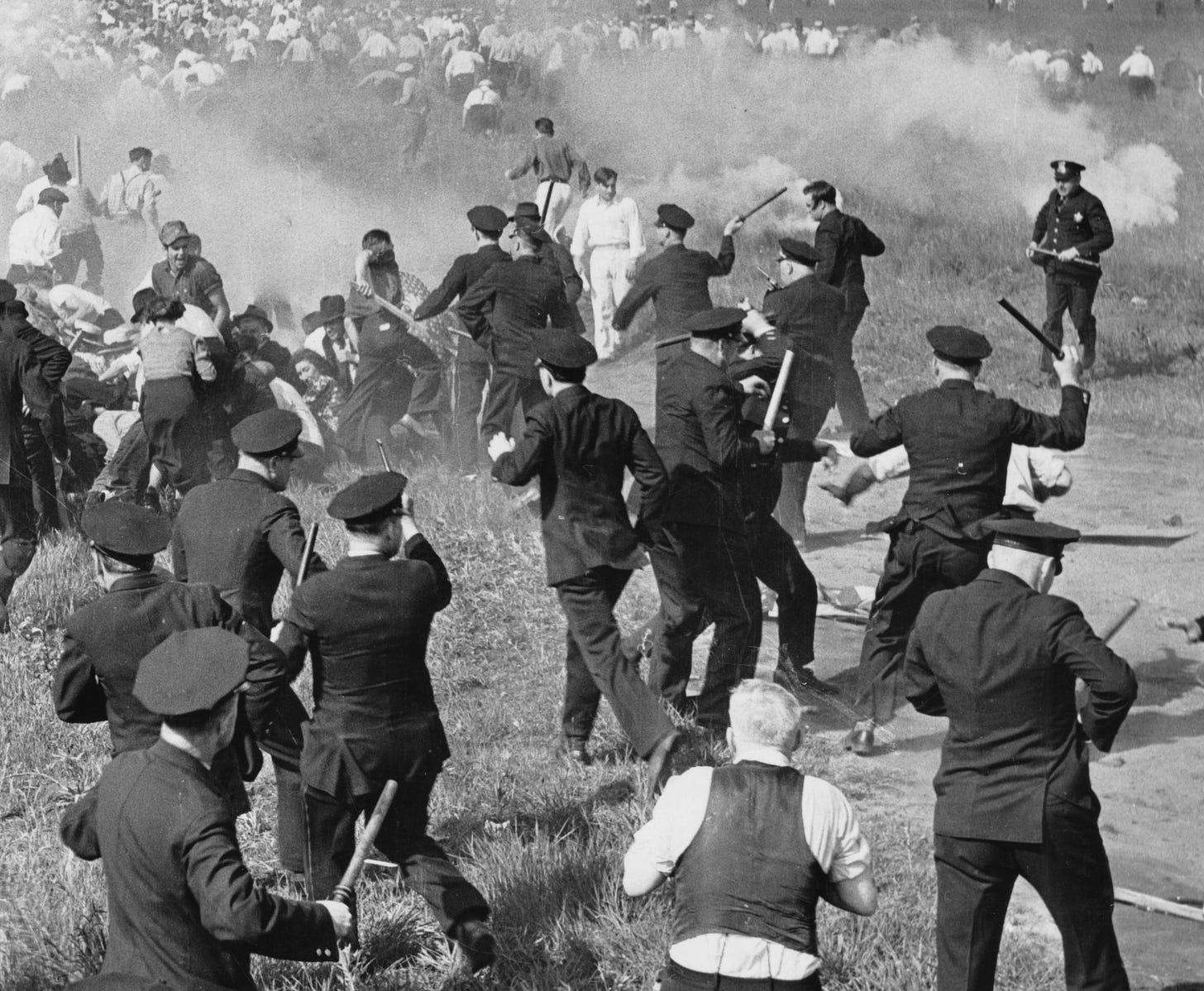
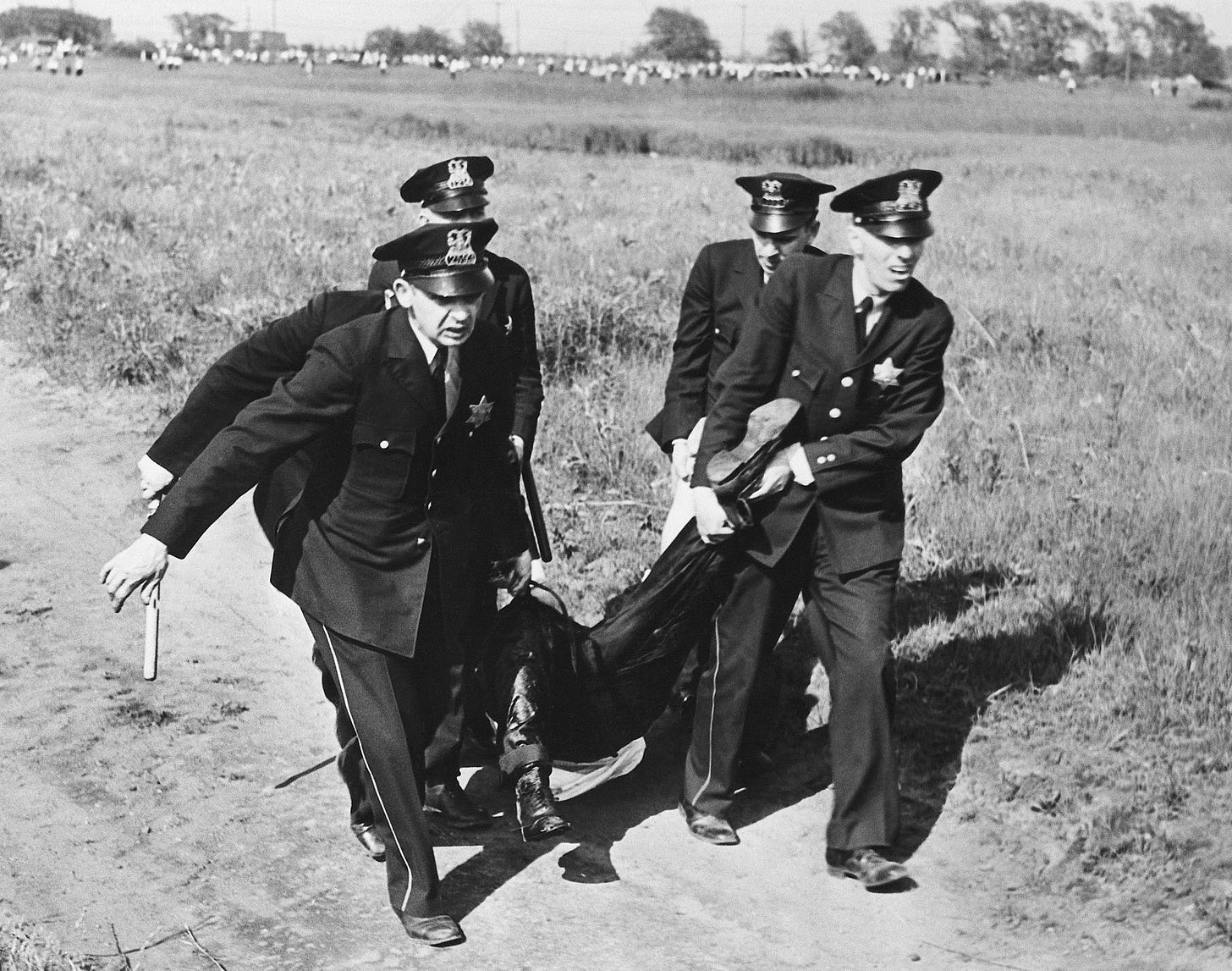
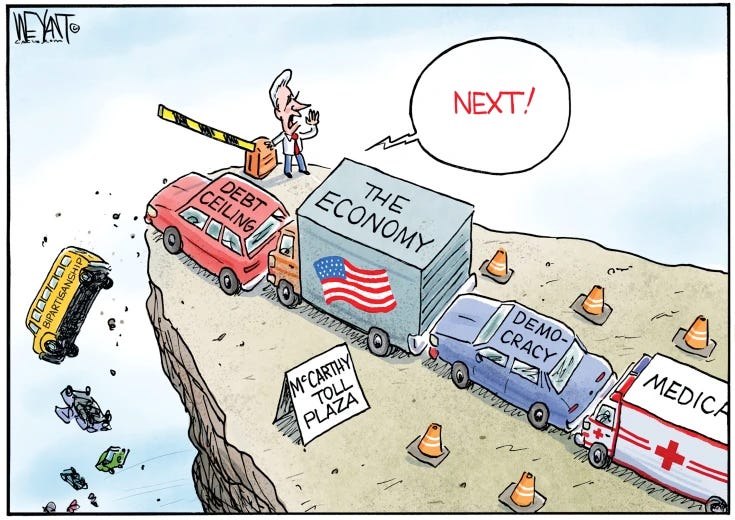
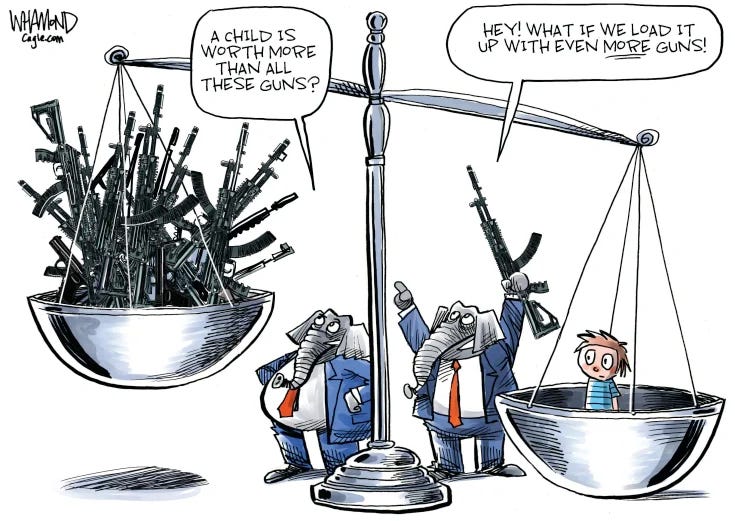
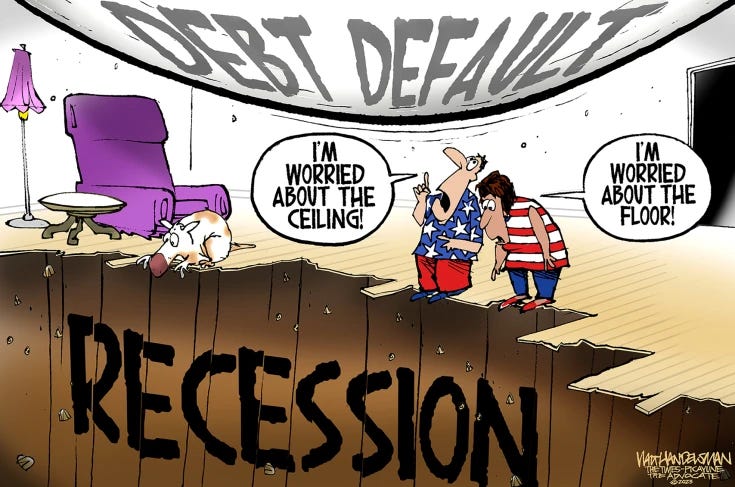
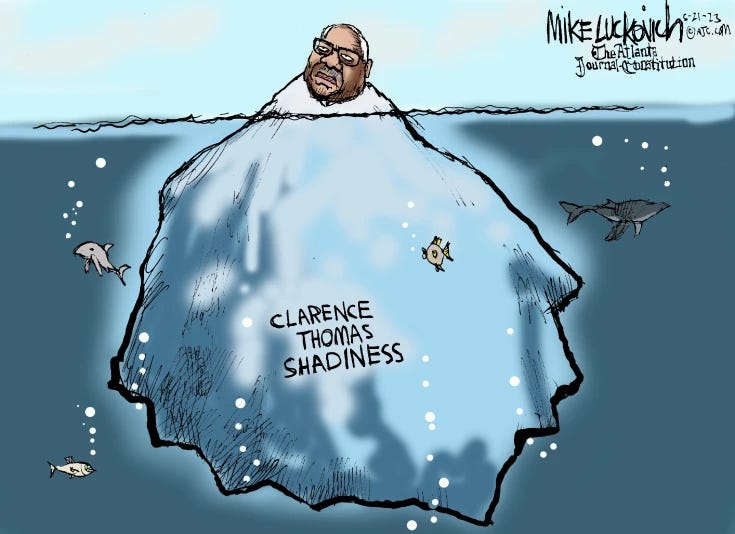
I just watched the film on my local PBS station. It’s unbelievable how little has changed since the massacre; police still killing civilians and lying about it. Thankfully we now have cellphones to record all such crimes. Greg, thanks for sharing this story, I look forward to reading your book.